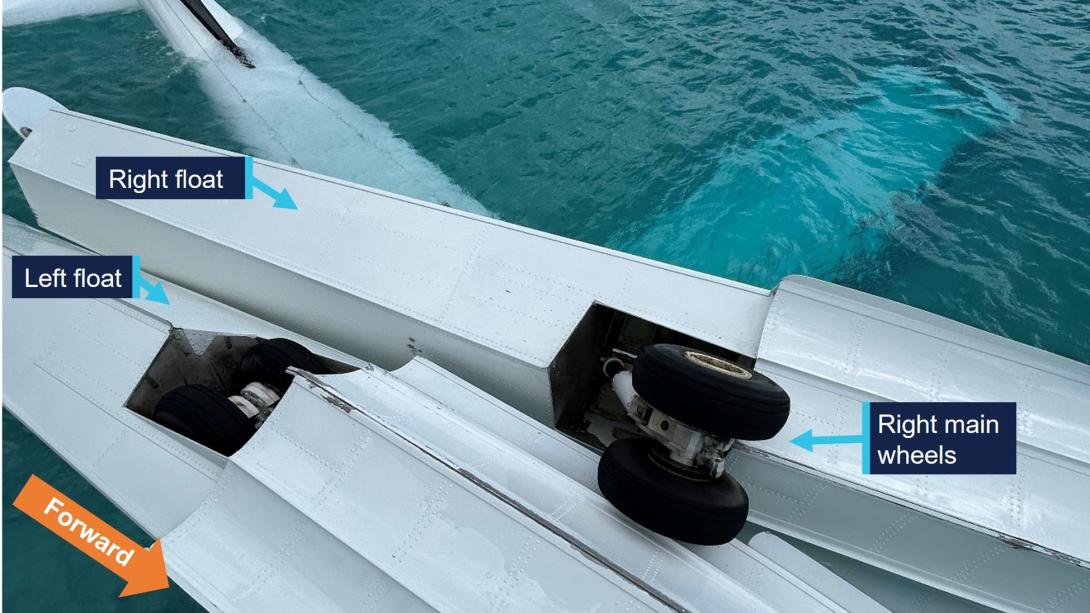
The pilot and passengers of a Beaver floatplane were unable to open the left rear cabin door to escape the aircraft after it overturned and became submerged on landing off Whitsunday Island’s Whitehaven Beach, an ATSB final report details.
The single-engine, amphibious DHC-2 Beaver had departed Hamilton Island Airport for a scenic flight to Whitehaven Beach with a pilot and four passengers on board on 26 October 2024.
After take-off the pilot selected the landing gear to retract but, likely due to corrosion, the right main landing gear assembly seized near the fully extended position.
“When the pilot was preparing for a water landing at Whitehaven Beach, they did not identify the right main landing gear had not retracted into the float during their pre‑landing checks,” ATSB Director of Transport Safety Kerri Hughes said.
The reason for the pilot not identifying the landing gear remaining extended, either via the landing gear position indication panel, the amphibian gear advisory system (AGAS) annunciation, or the wing‑mounted mirror, could not be identified. The investigation found that the AGAS was likely operational, but the pilot advised the ATSB that they did not recall hearing the AGAS annunciation just prior to the landing.
When the aircraft touched down with its right main landing gear still extended, it bounced and then yawed sharply to the right, before nosing over and becoming submerged inverted.
The pilot was able to exit the aircraft, but upon surfacing, realised none of the passengers had managed to do so.
The pilot swam back under the water to assist the passengers, but they were unable to open the aircraft’s left rear cabin door.
“Fortunately, the pilot was able to open the right main door – which took a degree of force – and assisted all four passengers to the surface,” Ms Hughes said.
All five occupants sustained minor injuries in the accident, and the aircraft was substantially damaged.
Ms Hughes noted a series of similar accidents led the Beaver’s then‑type certificate holder, Viking Air Limited, to publish a service bulletin in July 2010 strongly recommending the fitment of newly‑developed ‘push‑out’ windows, to improve emergency egress.
“These modifications were not fitted to the accident aircraft, nor were they required to be,” she said.
“This accident should highlight to operators and pilots the life‑saving value of having an alternate means of exiting an aircraft after an impact with water if the fuselage becomes distorted.”
In this instance, the circumstances that initiated the corrosion could not be determined. However, the operator enhanced their procedures for preventative maintenance on their aircraft and incorporated a minimum weekly systems check flight, including landing gear cycle when the aircraft had not been recently operated.
In response to this accident, the Civil Aviation Safety Authority (CASA) has developed an airworthiness bulletin, AWB 32‑029, recommending enhanced vigilance and maintenance actions on the landing gear components to ensure reliability of the landing gear and actuating system.
In addition, the operator installed a second mirror on the right wing of its DHC‑2 aircraft (the fleet was already equipped with a mirror on the left wing of the aircraft, designed to help pilots observe landing gear retraction). Further, the operator implemented initial and recurring pilot training that included enhanced flight characteristics highlighting techniques specific to amphibian aircraft operations.
Finally, the ATSB’s final report also notes the pilot credited their employer‑mandated helicopter underwater escape training (HUET), completed about one month before the accident, as a life‑saving course.
“In-rushing water, disorientation, entanglement, unfamiliarity with seatbelt release mechanisms and an inability to reach or open exits are all known challenges for occupants attempting to escape from a submerged aircraft,” Ms Hughes said.
“As such, HUET has the potential to be lifesaving, not just for helicopter pilots but for all pilots operating any type of aircraft over water,” Ms Hughes said.
Read the final report: Landing gear malfunction and collision with water involving de Havilland Canada DHC-2 Beaver, VH-OHU, near Whitehaven Beach, Whitsunday Island, Queensland, on 26 October 2024


